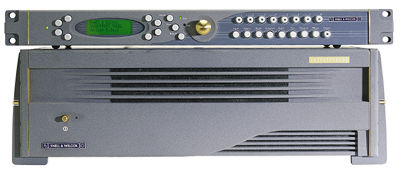Madrigal Imaging MP-9 CRT projector Snell & Wilcox G2 Interpolator Gold
Snell & Wilcox markets only one video scaler to the home-theater market, but it's one of the best in the business, and arguably the best. The G2 Interpolator Gold, the most current update of the original Interpolator, can be used in one of two ways.
First, it can be linked to and controlled by an outboard computer or third-party touchscreen control system such as an AMX or Crestron. In addition to full deinterlacing and line scaling of 480i sources, in a single step, this mode can be programmed to provide a wide range of easily accessed features. This option sells for $35,000, touchscreen and system-programming costs not included.

For $42,500, the system can be upgraded to provide even greater flexibility. At the user's command, customizable graphic control icons are laid over any currently displayed onscreen image. You could, for example, watch a movie in an onscreen window and simultaneously work on a spreadsheet or surf the Web by simply pointing and clicking on the appropriate onscreen buttons. This option requires a user-supplied PC. The G2 can also be linked with an outboard touchscreen control system.
The only Interpolator operating mode that interested us, however—watching full-motion video material in a home-theater setting—can be controlled in another way, without having to navigate a Windows-like graphic user interface. With an S&W control accessory dubbed the Shoebox, all of the G2's important home-theater features can be accessed. These include input selection, aspect ratio, and video settings, including a variety of Sharpness and Noise Reduction controls. There are also several geometry controls, including Picture Position, Size, and Zoom. There is also a Freeze mode, and additional, unlabeled buttons that can be programmed to perform other functions. This programming can be performed directly on the Shoebox in a setup mode, or by means of an external computer using S&W-provided software. Perhaps the most important setting is the choice of one of 16 available output resolutions. The characteristics and capabilities of the projector will determine the correct setting.
The G2 Shoebox sells for $37,500. Yes, that's obscenely priced by consumer standards, but S&W deals primarily with professional clients such as broadcast and mastering facilities. That also explains the plain, textured gray styling.
I won't take up space here describing the picture produced by the G2 Interpolator; if you've read the accompanying review of the Madrigal Imaging MP-9 CRT projector, you already know how good it is. But how did it compare with our long-term reference, the Faroudja DVP3000? I was able to set up a direct comparison between the two units using an output resolution of 960p on both, into the first sample of the Madrigal. The short answer: Both were superb. Despite persistent rumors that there's something subjectively superior about the S&W's color palette, when both scalers were set up for the same degree of color saturation, I found nothing to choose between them on that score. Faroudja does limit the color bandwidth to minimize artifacting, but this may have had more of an effect on subjective resolution (see below) than on color per se. While in a few difficult scenes the Faroudja seemed to do marginally better at avoiding motion artifacts, neither scaler caused me any concern in that respect. Artifacting was simply not an issue with either of them.
The two areas in which the S&W pulled out in front were detail and lack of video noise. Even ignoring its SDI capabilities with an appropriate source, with a component-video input the S&W was subtly crisper. At the same time, it had a smoother overall appearance, a creamier texture that did not sacrifice resolution. The only explanation I can propose for this difference is that the S&W's video circuits are just a little quieter than the DVP3000's—and the latter is by no stretch of the imagination "noisy." The differences between the two processors were subtle, with the S&W marginally but noticeably better in a direct comparison. It's also more than twice as expensive; at the level of quality represented by these two processors, improvements don't come cheap.
One last, important point: When Joel Brinkley reviewed the original Snell & Wilcox Interpolator Gold in December 1999, he raved about its image quality but was bothered by its unreliability. If my experience of several months' heavy use is any indication, that is not a concern with the G2.—TJN
- Log in or register to post comments



























































